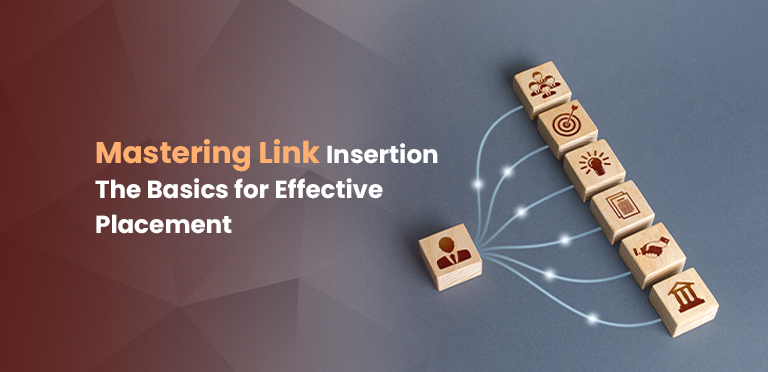Mastering Link Insertion: The Basics for Effective Placement



Did you know that backlinks remain one of the top three ranking factors in Google’s algorithm? Pages with a higher number of backlinks tend to rank higher in search results. This highlights the importance of strategic link-building for SEO success.
Link insertion is the practice of adding hyperlinks to existing content on external websites. Unlike guest posting, which requires creating new content, link insertion leverages pre-existing articles to gain backlinks, helping websites increase authority and organic search rankings more efficiently.
Effective link insertion for guest posting helps improve SEO by strategically placing backlinks within high-quality, relevant content on authoritative websites.
This article will break down the fundamentals of link insertion, explain its role in SEO, and provide best practices for effective implementation. Whether you’re an SEO beginner or a seasoned marketer looking to refine your strategy, this guide will help you master the art of link insertion.
Understanding Link Insertion
Link insertion is a powerful backlink strategy that involves strategically placing hyperlinks to your website within existing content on external sites. These links for a website not only help drive referral traffic but also improve SEO by signaling to search engines that your content is valuable and authoritative. Well-placed links can enhance your site’s credibility, helping it rank higher in search engine results.
Types of Link Insertions
Natural vs. Manual Insertions
- Natural Insertions occur when another website links to your content organically, without any outreach or request. This happens when your content is informative, authoritative, and relevant, making other site owners want to reference it. Natural backlinks are highly valuable because they indicate trust and credibility.
- Manual Insertions involve proactive outreach to website owners, bloggers, or content creators, requesting that they include an SEO link to your site within their content. This often requires relationship-building, networking, and demonstrating the value your content provides.
Paid vs. Organic Insertions
- Paid Insertions involve paying a website to include a link (for SEO) to your content, typically within a sponsored post, guest article, or advertisement. While effective, paid links should comply with Google’s guidelines to avoid penalties.
- Organic Insertions are earned through outreach, collaborations, and content marketing without financial transactions. This approach focuses on providing high-quality, link-worthy content that websites naturally want to reference.
When done strategically, link insertions can significantly enhance your SEO and website authority.
The Role of Link Insertion in SEO
Link insertion plays a critical role in search engine optimization (SEO), contributing to a website’s authority, visibility, and overall ranking potential. When executed strategically, it can help boost organic traffic, improve credibility, and enhance user experience. Below are the key ways link insertion benefits SEO:
Enhancing Domain Authority
Search engines like Google use backlinks as a measure of a website’s trustworthiness and credibility. When reputable sites link to your content, it signals to search engines that your site is a reliable source of information.
This strengthens your domain authority (DA), which is a crucial factor in determining your ability to rank for competitive and relevant keywords. Higher domain authority often leads to better rankings and increased organic traffic over time.
Improving Search Engine Rankings
Backlinks serve as endorsements in Google’s algorithm, influencing how search engines evaluate your website’s relevance and quality. Web pages with a higher number of high-quality backlinks tend to rank better in search engine results pages (SERPs).
A well-planned link insertion strategy ensures that your website earns links from authoritative, niche-relevant sources, helping you outrank competitors.
Driving Referral Traffic
Beyond SEO, link insertions can generate valuable referral traffic. When your link appears on high-authority websites, it attracts targeted audience who are genuinely interested in your content, products, or services. This can lead to increased engagement, conversions, and brand awareness.
Building Brand Credibility and Trust
Having your website linked from established industry sources strengthens your brand credibility. Users are more likely to trust and engage with your content when they see it recommended by a reputable site. This trust can translate into higher user retention and customer loyalty.
Accelerating Indexing and Crawling
Search engine bots discover new pages by following links. Link insertions on well-indexed websites help Google crawl and index your pages faster, ensuring your latest content is visible in search results sooner.
By leveraging link insertion effectively, you can enhance your website’s authority, search rankings, and online visibility, ultimately driving long-term SEO success.
Best Practices for Effective Link Insertion Placement for SEO
To fully leverage link insertion for SEO success, it’s essential to follow best practices that ensure high-quality backlinks, natural integration, and long-term benefits. Below are the key strategies for effective link insertion:
1. Relevance of Content
The linking page should align closely with your industry, niche, or topic to ensure the link provides value to both users and search engines. Search engines prioritize contextually relevant backlinks, as they indicate that the linked content enhances the reader’s understanding of the subject. Additionally, the surrounding text should seamlessly relate to the linked page’s topic to create a cohesive user experience.
2. Authority of the Host Site
Not all backlinks hold the same value. It’s crucial to target websites with high domain authority (DA) and strong reputations to maximize the SEO impact. Tools like Moz’s Domain Authority, Ahrefs’ Domain Rating, and SEMrush’s Authority Score can help assess a site’s credibility. A backlink from an authoritative, high-traffic site carries more weight than multiple low-quality links.
3. Natural Integration
The inserted link should fit organically within the content. Avoid placements that feel forced or disrupt the readability of the article. Search engines may flag unnatural link insertions as spammy, potentially harming your SEO. Instead, links should provide additional context, enhancing the reader’s experience.
4. Anchor Text Optimization
Anchor text plays a significant role in SEO. Use keyword-rich, descriptive anchor texts that naturally blend into the content while accurately reflecting the linked page. However, avoid over-optimization or excessive exact-match keywords, as this may trigger search engine penalties. A mix of branded, generic, and partial-match anchors works best.
5. Monitoring and Maintenance
Regularly audit inserted links to ensure they remain active and relevant. Over time, external pages may change, links may break, or their value may diminish. Using tools like Google Search Console, Ahrefs, or SEMrush, you can track backlink performance, analyze referral traffic, and make necessary adjustments to maintain SEO benefits.
By following these best practices, you can maximize the effectiveness of link insertion, ensuring long-term SEO gains and sustainable website growth.
Common Pitfalls to Avoid in Link Insertion
While link insertion can be a powerful SEO strategy, mistakes can lead to penalties or diminished results. To maintain an effective and ethical link-building tactic, avoid these common pitfalls:
1. Over-Optimization
One of the biggest mistakes in link insertion is the excessive use of exact-match anchor texts—where the anchor text precisely matches a high-value keyword. While linking, keyword-rich anchor texts are beneficial, however, overusing them can trigger search engine penalties, making your link profile appear unnatural.
Instead, maintain a diverse anchor text strategy, incorporating branded terms, partial-match keywords, and natural phrases to ensure a balanced and organic profile.
2. Irrelevant Link Placement
Inserting links into unrelated or low-quality content diminishes SEO value and creates a poor user experience. If the link placement does not align with the surrounding content, it can confuse readers and reduce engagement.
Google values contextual relevance, so ensure that the linking page and your website share a logical connection. Links should naturally contribute to the reader’s understanding of the topic.
3. Ignoring Quality Over Quantity
A common misconception is that more backlinks automatically mean better rankings. However, high-quality backlinks from authoritative, niche-relevant sites carry far more weight than dozens of links from low-authority or spammy domains.
Prioritize trusted sources over mass link-building strategies that focus solely on quantity. Quality backlinks enhance domain authority, credibility, and search engine trust while mitigating risks of algorithmic penalties.
By avoiding these pitfalls, you can build a sustainable and effective link insertion strategy that strengthens your SEO efforts.
Tools and Resources for Link Insertion
Leveraging the right tools can significantly enhance your link insertion strategy, helping you identify opportunities, analyze backlinks, and manage outreach efficiently. You can use tools like Ahrefs, SEMrush, or Google Search Console to search for websites that link to your website and analyze your backlink profile for SEO improvements. Below are some essential tools to optimize your efforts:
SEO Analysis Tools
- Ahrefs – One of the most powerful backlink analysis tools, Ahrefs allows you to analyze your backlink profile, track competitors’ links, and find high-quality link insertion opportunities. Its Site Explorer and Content Explorer features help identify relevant websites for outreach.
- SEMrush – Provides in-depth insights into competitors’ backlinks, enabling you to uncover potential link insertion opportunities. Its Backlink Gap tool helps compare your backlink profile with competitors, identifying websites where your links could be placed.
Outreach Platforms
- BuzzStream – A relationship-building and outreach tool that helps manage email outreach, track responses, and organize link-building campaigns efficiently.
- Pitchbox – Automates and streamlines the prospecting and outreach process, making it easier to connect with website owners, bloggers, and content creators for potential link insertions.
By using these tools, you can enhance your link-building efficiency, improve backlink quality, and gain a competitive edge in SEO.
Conclusion
Link insertion is a valuable SEO strategy that enhances domain authority, improves rankings, and drives targeted traffic. To execute it successfully, focus on content relevance, authoritative sites, natural integration, and proper anchor text usage.
By implementing these strategies, you can significantly boost your website’s SEO performance. Optimizing your inside link structure helps improve website navigation and boosts SEO performance. Start by identifying high-authority sites and incorporating best practices into your link insertion strategy.
Need expert help with your link-building efforts? At Phoenix SEO Ninja, we specialize in providing strategic link insertions services that drive real results. Contact us today to elevate your SEO and dominate search rankings!
Frequently Asked Questions (FAQs)
It depends on the length and quality of the content. Generally, 1-3 relevant article links used per 1000 words is ideal.
Use a mix of branded, partial match, and natural anchor texts to avoid over-optimization penalties.
Yes, but it should make sense contextually. Overuse of the same link may dilute its SEO value.
Use SEO tools like Ahrefs and SEMrush to identify authoritative websites in your industry.
No. Guest posting involves creating new content for an external site, while link insertion adds your link to existing content.
Monitor referral traffic, domain authority, and target keyword ranking improvements using tools like Google Analytics and Ahrefs.
Yes, linking to authoritative and relevant sites can help SEO by improving content credibility, enhancing user experience, and signaling to search engines that your content is well-researched.